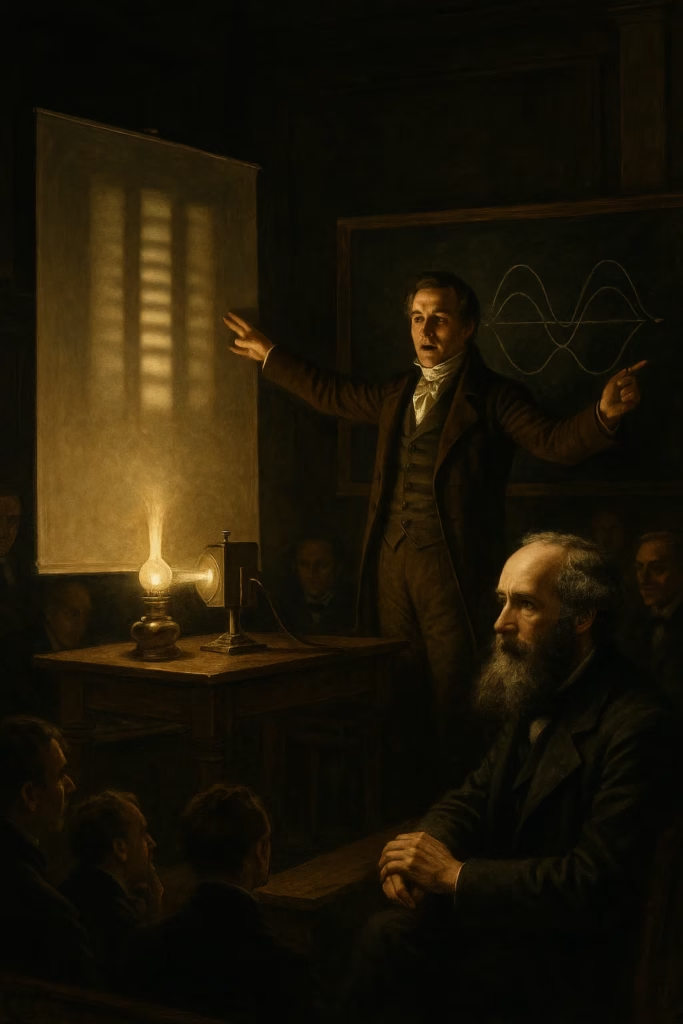Newton’s corpuscular dogma had dominated science for an entire century. It seemed the question of the nature of light was settled by the authority of the greatest genius of his age. But truth, as we have seen, has a habit of breaking through – even through the narrowest of slits.
🌀 Young: The Man Who Knew Everything and Saw Waves
At the beginning of the 19th century, one of the most versatile minds in human history entered the scene – Thomas Young. A physician by profession, he was also a polyglot (speaking over ten languages), an Egyptologist (key to deciphering the Rosetta Stone), a music theorist, and a true erudite. His contemporaries described him as “the man who knows everything.”
Inspired by Huygens’ work, Young designed a simple yet genius experiment that would forever change the course of physics: the double-slit experiment.
Imagine light passing through a single very narrow slit in an opaque barrier. On the screen behind it, we would expect to see a single bright line. However, when Young used two narrow slits close to each other, an astonishing pattern appeared on the screen: alternating bright and dark fringes.
This phenomenon was irresistibly reminiscent of the patterns created by water waves when they meet. When two waves meet, their crests can align (constructive interference) and amplify, or the crest of one can meet the trough of another and cancel out (destructive interference). Young recognized precisely this: interference. This was a fatal blow to Newton’s theory – particles cannot cancel each other out in this way; only waves can.
Young also corrected one of Huygens’ errors. While Huygens believed light waves were longitudinal (like sound), Young concluded they were transverse (like a wave on a string), which was key to explaining the newly discovered phenomenon of polarization – the property of light becoming “oriented” in a specific direction, which occurs when passing through crystals like calcite.
As a physician, Young also proposed a theory of color vision, hypothesizing that the human eye has three types of receptors sensitive to different colors. This trichromatic theory was fully confirmed a century and a half later.
📐 Fresnel: The Mathematician Who Gave Wings to the Wave Theory
Young’s ideas found their chief advocate in the French engineer and physicist, Augustin-Jean Fresnel. He provided a solid mathematical framework for the wave theory, refined Young’s experiments, and explained the phenomenon of diffraction (the bending of light around the edges of obstacles) with incredible precision. Fresnel’s calculations were so convincing that they practically “closed the door” on Newton’s theory in scientific circles. The wave theory had triumphed.
⚡ Maxwell: The Man Who Unified Light, Electricity, and Magnetism
But what are these waves? What medium do they propagate through? These questions puzzled scientists until the second half of the 19th century.
The answer came from an unexpected direction – from the study of electrical and magnetic phenomena. The brilliant experiments of Michael Faraday revealed a deep connection between these two forces. But Faraday was not a mathematician. The theoretical framework that explained all his results – and much, much more – was provided by the Scottish physicist James Clerk Maxwell.
Maxwell formulated his famous four equations that unified electricity and magnetism into a single force – electromagnetism. In their elegant differential form, they are:
- ∇⋅E = ρ/ε₀ (Gauss’s law for electricity)
- ∇⋅B = 0 (Gauss’s law for magnetism)
- ∇×E = -∂B/∂t (Faraday’s law of induction)
- ∇×B = μ₀J + μ₀ε₀∂E/∂t (Ampère-Maxwell law)
From this beautiful mathematical theory emerged a wave equation, and from it came the prediction of electromagnetic waves propagating through space at a speed… which Maxwell calculated to be approximately 300,000 km/s.
The speed was astonishingly familiar. It was the speed of light.
Maxwell boldly concluded: light is nothing but an electromagnetic wave. Visible light is just a small part of the vast electromagnetic spectrum, which includes radio waves, microwaves, infrared and ultraviolet radiation, X-rays, and gamma rays.
It seemed the nature of light was finally solved. It was a beautiful, complete, and closed theory. The scientific world breathed a sigh of relief. The path to a complete understanding of the Universe seemed laid out before them.
But the truth, as always, was stranger and wilder. In the next post, two German scientists – Max Planck and Albert Einstein – will shake the very foundations of this perfect theory and open the door to a new, even stranger world: the world of quanta.


Leave a Reply